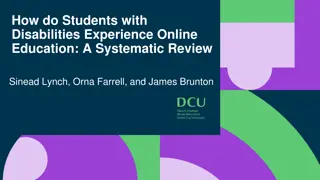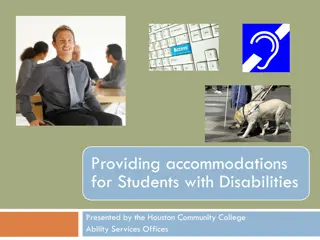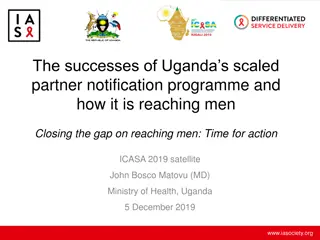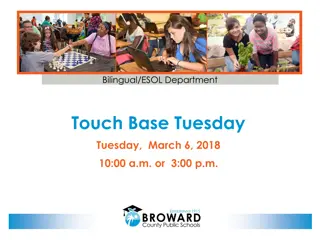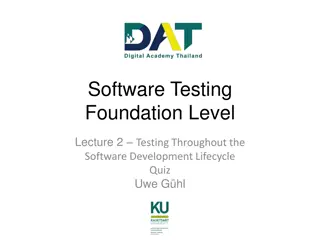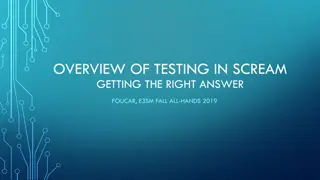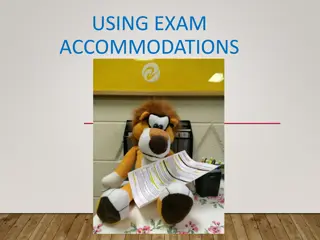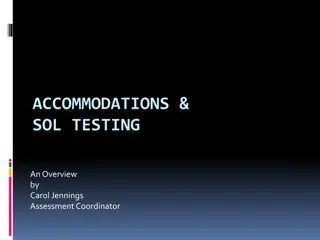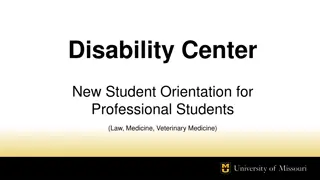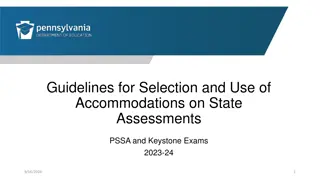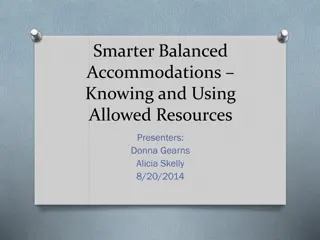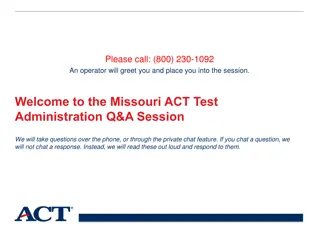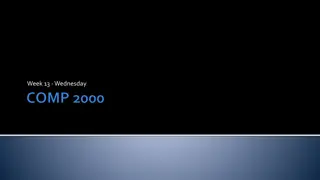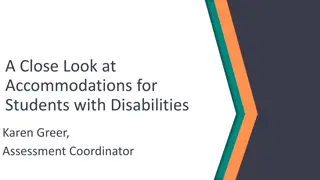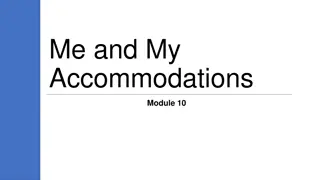Accommodations & SOL Testing for EL Students
This overview by Carol Jennings, Assessment Coordinator, covers accommodations and SOL testing for English Learner (EL) students. It emphasizes the importance of following established guidelines for administering tests with accommodations, providing insights into online testing requirements, class size specifications, and considerations for testing disruptive students. The document serves as a guide and highlights the necessity of referring to official manuals and documents provided by the Virginia Department of Education.
Download Presentation

Please find below an Image/Link to download the presentation.
The content on the website is provided AS IS for your information and personal use only. It may not be sold, licensed, or shared on other websites without obtaining consent from the author.If you encounter any issues during the download, it is possible that the publisher has removed the file from their server.
You are allowed to download the files provided on this website for personal or commercial use, subject to the condition that they are used lawfully. All files are the property of their respective owners.
The content on the website is provided AS IS for your information and personal use only. It may not be sold, licensed, or shared on other websites without obtaining consent from the author.
E N D
Presentation Transcript
Accommodations & SOL Testing for EL Students An Overview by Carol Jennings Assessment Coordinator (2021-2022)
Disclaimer This presentation is not meant to be the only document STCs, Test Examiners, and Proctors use when testing students who need accommodations. It is only designed to be a guide. The Test Implementation Manual and the Examiner s Manual as well as the documents listed on the last page of this document should be read and followed in their entirety prior to administering a test with accommodations to a student, and all guidelines as established by the Virginia Department of Education should be followed. 2
Online Testing All students are required to take the online version of the SOL tests except in very specific circumstances. The student attends school in a location where a secure network connection or the required technology is not available (i.e., BRACC, Minnick, etc.). The student s accommodation requires a paper/pencil test (i.e., Large Print, Braille, or a flexible day schedule that requires multiple testing sessions over more than a day for non-CAT assessments more than two days for CAT assessments). The student has a documented medical condition (i.e., seizures) when exposure to a computer aggravates the condition. 3
Allowable for ALL Students Small Group Size The Virginia Department of Education does not specify the number of students that constitutes class size; thus, classes of students can be broken into smaller groups for testing for example, individual, groups of 5, groups of 10, etc. 5
Allowable for ALL Students Small Group Size (continued) Anticipate those students who may be disruptive and remove them from the whole-class setting BEFORE testing starts. A good place to put them is with a person of authority. Schools should plan to test students without a plan in whole- group settings unless you determine the student will create an irregularity because of behavior issues or there are other extenuating circumstances. Staffing and resources at the school level dictate if the school can accommodate small group or one-on-one testing for students without a plan. 6
Allowable for ALL Students Small Group Size (continued) Before a student without a plan is placed into a small group or one-on-one test sessions, please document the following throughout the year: The class assessments the student takes in a small group or one-on- one setting The benchmark assessments the student takes in a small group or one-on-one setting Evidence indicating this is the best setting The small groups students are placed in will include students who have a plan and may be disruptive during the test. Therefore, please note that small groups and one-on-one settings may not be the best testing environment for a student. 7
Allowable for ALL Students Small Group Size (continued) When considering students for small group and one-on-one testing, consider the following: Why does the student need the small group or one-on-one setting is it a matter of access to the SOL, parent request, teacher request? Can you offer small groups/one-on-one testing given your staffing? Can the receiving schools (i.e., middle schools) continue this practice of small group or one-on-one setting? Are you setting students up with a testing environment that is not practicable in future years? 8
Allowable for ALL Students Environmental Modifications Students may NOT be issued any kind of accessory to modify the environment. Accessories include, but are not limited to: Head phones Ear plugs Ticking clocks Egg timers Stress balls Toys Music or soothing sounds 9
Allowable for ALL Students Students Reading Aloud to Themselves Students who test better when they read aloud to themselves would need to be tested in a separate setting because the student reading aloud would be disruptive to other students. This strategy pairs with a previous slide which discusses removing potentially disruptive students BEFORE testing begins. NOTE: Regular education students may not use whisper phones. 10
Allowable for ALL Students Scratch Paper Students can have scratch paper for all tests. The scratch paper must be school issued and cannot be the student s own paper. All the scratch paper must be the same color. All scratch paper must be collected and accounted for at the end of the test. Students should write their name on each sheet of paper. Scratch paper must be turned in to the STC. The STC will shred all scratch paper 11
Allowable for ALL Students Scratch Paper (continued) Scratch paper may include: Plain paper (no lines) Lined paper all the same shade Graph paper Sticky notes Note cards The sticky notes and note cards must be all the same color. Particular care must be taken to ensure all sticky notes and note cards are accounted for after the test (i.e., number them prior to handing them out and then check the numbers when they are picked back up) Paddy paper paper/pencil ONLY Enhanced Scratch Paper is Prohibited (e.g., puffy lines or some lines darker than others) 12
Allowable for ALL Students Large Diameter Pencil Must contain #2 lead if used for paper/pencil test Special Pencil Must contain #2 lead if used for paper/pencil test Pencil Grip 13
Allowable for ALL Students Assistance with Directions Examiners may simplify or clarify the bold directions which are read to the students that explain howto take the test. Examiners and Proctors may not provide assistance with directions for test items withinthe student s test. 14
Allowable for ALL Students Health Management Devices The Health Management Device Form must be completed for each student with a documented health need who requires the use of a health management device during SOL testing. Students may or may not have a plan The completed form ensures that students who need the health management device have use of it while also ensuring the integrity of the SOL test administration. The form must be completed at each school and sent to the DDOT for review and approval. If applicable, the DDOT will forward the form to the VDOE for further review. 15
Students w/ Disabilities, 504 & EL Students Please follow the Accommodations Charts from the Testing Manuals very carefully as all accommodations are not available for every test. EL students are not allowed all accommodations unless they also are identified as a student w/ a disability or 504. Follow the Special Testing Accommodations Guidelines carefully in the Test Implementation Manual and the Examiner s Resource Guides. 17
Students w/ Disabilities, 504 & EL Students Multiple Test Sessions (Accommodation Code 1) Testing over two or more school days (three or more if CAT grades 3, 4, or 5 Reading & Math and grades 6 or 7 Math) Requires a paper/pencil test Not permitted on the Short-Paper Component of the Grade 8 & EOC Writing assessments The student must have access only to questions administered on that particular day: Break the book apart and give the student only that portion of the test s/he will take on any given day. The student may not look forward to test questions for another day or look back at questions answered on a prior day. 18
Students w/ Disabilities, 504 & EL Students Visual Aids (Accommodation Code 4) Template paper/pencil test only Must be blank and allows student to see one word, sentence, or line of print at one time *THIS IS THE ONLY ACCOMMODATION UNDER VISUAL AIDS EL STUDENTS MAY USE UNLESS DUAL IDENTIFIED Markers may be used to allow the student to maintain his/her place 19
Students w/ Disabilities, 504, & EL Students* Test Directions Delivery (Accommodation Code 7) Students may be given written directions to accompany oral directions. *THIS IS THE ONLY ACCOMMODATION UNDER TEST DIRECTIONS DELIVERY EL STUDENTS MAY USE UNLESS DUAL IDENTIFIED Must be in English only May only be the State directions no additional directions The bold, SAY testing directions from Examiner s Manual Student s photo copy must be reviewed by a second staff member to ensure all the SAY directions are included and non-bold directions are not included. 20
Students w/ Disabilities, 504 & EL Students Read Aloud Test Items (Accommodation Codes 10 Items Math, Science, History, & Writing & Code 14 Reading) The Reading test may be read aloud ONLY if the student has a documented significant decoding disability or a documented visual impairment this student is dual identified. Difficulty reading the test or reading below grade level are not justifiable reasons for administering an audio. 21
Students w/ Disabilities, 504 & EL Students Read Aloud Test Items (continued) EL students may NOT have a read aloud accommodation on the Reading test unless they also are identified as a student with a disability/504. Exceptions(HIGH SCHOOL STUDENTS ONLY) to the previous slide on the EOC Reading test considered a non- standard accommodation and code accommodation B and coded as Retest : Student is retaking the EOC Reading test, having failed without using the read-aloud or audio accommodation. Student s IEP/504/EL plan lists the read aloud or audio accommodation. Student receives the read aloud or audio accommodation on a regular basis in the classroom. 22
Students w/ Disabilities, 504 & EL Students Read Aloud Test Items (continued) The Math, Science, History, and Writing assessment is allowed for students as specified in their EL plan. Special attention must be given to students IEP, 504, and EL plans to determine how the test is to be administered must be specified in the student s plan. The entire test read aloud Words, questions, or sentences read aloud only upon the student s request 23
Students w/ Disabilities, 504 & EL Students Read Aloud Test Items (continued) The test must be read aloud in English. The Test Examiner must be very careful to not lead the student to the correct answer when reading test items aloud. Through intonation Through facial expressions or other non-verbal clues By repeating any part of the test that is not specifically requested by the student In describing graphics 24
Students w/ Disabilities, 504 & EL Students Read Aloud Test Items (continued) An examiner who administers a read-aloud test session must be familiar with how to read test items to students. Prior to testing, examiners must (this is mandatory and must be documented and turned into the STC): Listen to an audio practice test prior to testing Read Guidelines for Administering the Read-Aloud Accommodation for Standards of Learning Assessments The test session must be recorded or monitored by a second person. 25
Students w/ Disabilities, 504 & EL Students Read Test Items for Computer Adaptive Tests (Accommodation Codes 10 & 14) All guidelines on the previous slides for Reading Aloud Test Items must be followed The assessment must be administered one-on-one. The student must be seated directly in front of the computer, and the Test Examiner must sit to the side of the student and read from the student s workstation. 26
Students w/ Disabilities, 504 & EL Students Audio Version of the Test (Accommodation Codes 11 Math, History, Science, & Writing & Code 15 Reading) Students may have the audio accommodation for Math, History, Science, or Writing assessments as specified in their IEP/504/EL plan. Students must have access to regular print (online or paper), large print, or Braille as the audio plays. 27
Students w/ Disabilities, 504 & EL Students Audio Version of the Test (continued) The Reading test may be audio ONLY IF the student has a documented significant decoding disability or documented visual impairment dual identified student. Difficulty reading the test or reading below grade level are not justifiable reasons for administering an audio. 28
Students w/ Disabilities, 504 & EL Students Audio Version of the Test (continued) EL students may NOT have an audio accommodation on the Reading test unless they also are identified as a student with a disability/504 (see the above bullet). Exceptions (HIGH SCHOOL STUDENTS ONLY) to the above on the EOC Reading test considered a non-standard accommodation and code accommodation B and coded as Retest : Student is retaking the EOC Reading test, having failed without using the read-aloud or audio accommodation. Student s IEP/504/EL plan lists the read aloud or audio accommodation. Student receives the read aloud or audio accommodation on a regular basis in the classroom. 29
Students w/ Disabilities, 504 & EL Students Audio Version of the Test Online Guidelines (continued) The IEP Team/504 or EL Committee must determine whether the read aloud or audio form of the test is the most appropriate delivery method for online testing. The parent must agree to delivery method, and the decision documented in the student s plan. The online audio accommodation may be given to students who typically receive a read aloud during instruction or those who use recorded media or text readers in the classroom. Students should practice with the audio Practice Items available on the VDOE website. www.doe.virginia.gov/testing/sol/practice_items/testnav8.shtml 30
EL Students Bilingual Dictionary (Accommodation Code 17) The bilingual dictionary is available ONLY to EL students and is available for all SOL assessments. The bilingual dictionary must be offered individually to students not shared. The bilingual dictionary must be paper and not electronic. The bilingual dictionary must be a general, word-to-word bilingual dictionary. The bilingual dictionary cannot be content specific, a rhyming dictionary, a picture dictionary, etc. The bilingual dictionary must not be altered with hand-written notes. 31
EL Students Bilingual Dictionary (continued) The EL student must be familiar with the bilingual dictionary. SOL testing should not be the first time the student sees the dictionary. The bilingual dictionary may be school-owned or student-owned. The bilingual dictionary may be used alone or in conjunction with an English dictionary without a Thesaurus. NOTE: The English dictionary is not allowed on the multiple-choice component of the 2010 SOL writing test. 32
Students w/ Disabilities, 504 & EL Students Examiner Records Responses (Accommodation Code 18) Student who cannot respond by marking an enlarged answer document or by selecting the answer online may have an Examiner/Proctor record their responses. The student may mark in test booklet, respond verbally, point, or otherwise indicate a response. The Examiner must transfer the student s responses to the regular answer document or select them on the student s testing device. Test session should be recorded or monitored. Answers must be verified by a second school employee. 33
Students w/ Disabilities, 504 & EL Students Examiner Records Responses (continued ) If the student marks in his/her own test booklet, the student s name should clearly be printed on the test booklet and the booklet returned with all other test materials. The student may give the Examiner directions on how to respond to TEI items by responding verbally, pointing, or otherwise indicating his/her answer. 34
Students w/ Disabilities, 504 & EL Students* Dictation to a Scribe (Accommodation Code 25) Short-Paper Component *ELs may use Dictation to a Scribe for the Short-Paper Component ONLY. The test session must be recorded or monitored by a second person. The student dictates in English to respond to the short-paper component of the Writing assessment. The scribe must have experience working with the student. The scribe must not discuss test, provide hints or clues, give reminders, give verbal indications or non-verbal cues about the correctness of a response. The scribe must format, capitalize, and punctuate only as directed by the student. 35
Students w/ Disabilities, 504 & EL Students Dictation to a Scribe (continued) The scribe may type the student s response directly into the student s response area in TestNav. The student will make revisions on the response area and then submit the paper. The scribe may type the student s response on a word processor using a different device than the one running TestNav. The student may make revisions either on the word processor or on a printed copy. A final paper copy is printed and is used for transcription into the response area in TestNav.. The scribe may handwrite the student s response. The student may make revisions on the hand-written copy. The final paper is transcribed into the response area of TestNav. 36
Students w/ Disabilities, 504 & EL Students Dictation to a Scribe (continued) The information typed into TestNav must be verified by a second person (school personnel). The typewritten or handwritten paper must be turned into the STC and will be maintained on file in the DDOT s office. 37
Students w/ Disabilities, 504 & EL Students English Dictionary (Accommodation Code 29) The English dictionary may be used alone or with the bilingual dictionary on Non-Writing SOL tests and the short-paper component of the Writing SOL. The dictionary must be a general dictionary without a thesaurus. The dictionary must not be a specialized (e.g., content specific, rhyming dictionary, picture dictionary, etc.). The dictionary must be a paper dictionary. An electronic dictionary is not allowed. It may be school owned or student owned. It should be familiar to the student. The dictionary must not be altered in any way with hand-written notes or include class notes. 38
Students w/ Disabilities, 504 & EL Students English Dictionary (Accommodation Code 29) Only EL students may use an English dictionary on the Reading, Math, History, and Science assessments. EL students cannot use an English dictionary on the Multiple- Choice Component of the Writing SOL. Because the English dictionary may provide definitions of subject- specific vocabulary that ELs are expected to know for the SOL tests, the use of this testing accommodation should be carefully considered. 39
Students w/ Disabilities, 504 & EL Students Flexible Schedule (Accommodation Code 31) All SOL assessments are untimed, and ALL students may take the entire day to test if needed. Students w/ disabilities, 504, and EL students can have supervised breaks during the day The schedule for breaks must be determined prior to testing and based on the routine use of scheduled breaks during regular classroom and benchmark assessments. The frequency of breaks must be documented in the student s IEP/504/EL Plan. The STC and Test Examiner must have a system for notifying the student to begin and end a break during testing. 40
Students w/ Disabilities, 504 & EL Students Flexible Schedule (continued) The break must be supervised and test security must be maintained during the break. Students must be not allowed to discuss the test in any way, have access to educational materials or electronic devices, and must not disrupt other students during the break. The student s test materials must not be accessible or viewable by other students or school personnel during the break. If the student is taking the test online and the room is securely maintained, the monitor can be turned off. The student may exit the test, and then have his/her test resumed by the STC prior to logging back into the test. 41
Students w/ Disabilities, 504 & EL Students Resources: Students with Disabilities: Guidelines for Special Test Accommodations English Learners: Guidelines for Participation in the Virginia Assessment Program Guidelines for Administering the Read-Aloud Accommodation for Standards of Learning Assessments Explanation of Testing Accommodations with Disabilities Math Aids Accommodation Code 19 Explanation of Testing Accommodations for Students with Disabilities Assistive Technology Accommodations 42
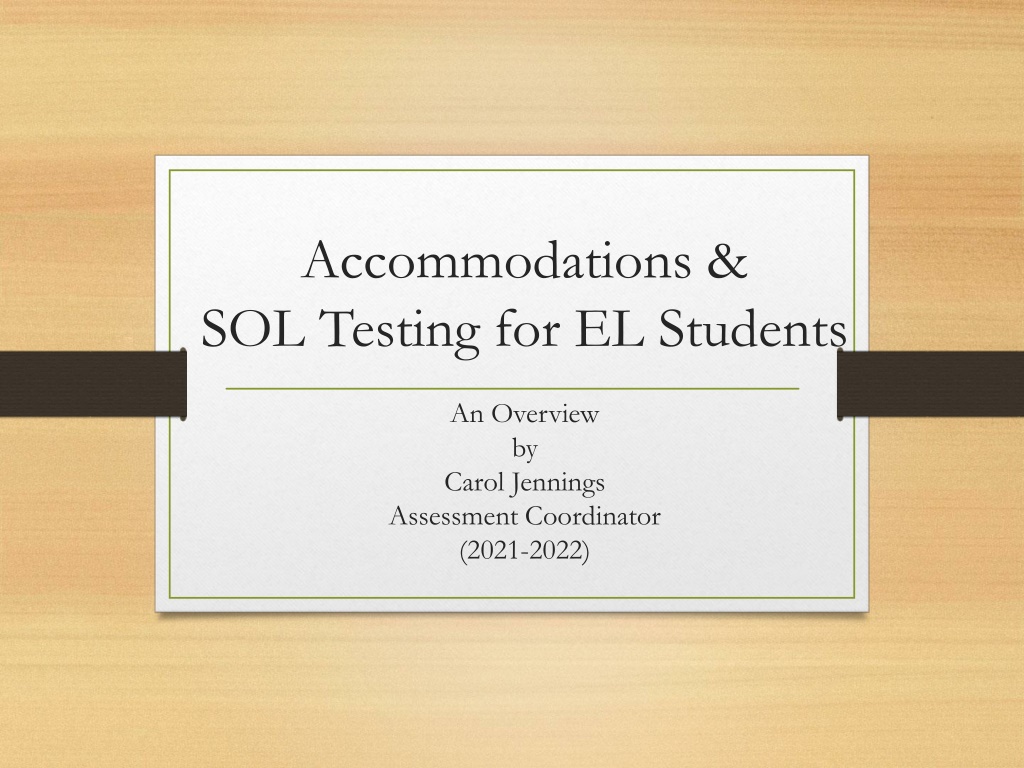
 undefined
undefined








